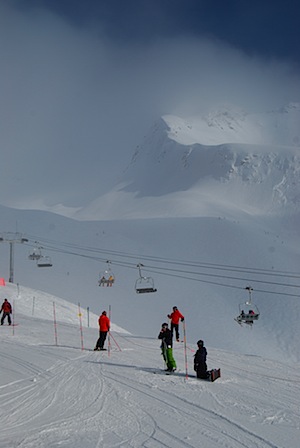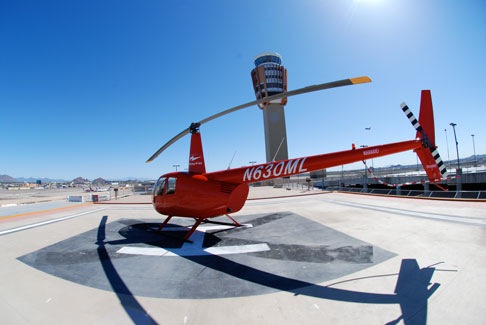A few notes from a brief trip.
I was in the Anchorage, Alaska, area this past week, from about 12:30 PM on Tuesday through 8 AM on Friday. I got home last night.
I was up there for a pilot job interview. The reason I needed 2+ days is because the weather is ever-changing and we wanted to make sure I’d have a chance to fly. I did, on Thursday, and surprised myself by landing atop a snow-covered ridge and making the steepest confined space landing I’d ever attempted. But all that is another story.
The Weather
 This was only my second visit to Alaska. (The first was last June.) I expected it to be cold and miserable. I was pleasantly surprised. Although it was cold, it wasn’t nearly as cold as I expected. Daytime temperatures hovered in the low 30s each day, dropping down into the low 20s at night. With a borrowed down jacket and the right footwear, I didn’t feel that cold. And although there was some snowfall each day, there wasn’t enough to consider the weather bad. In fact, it was rather nice.
This was only my second visit to Alaska. (The first was last June.) I expected it to be cold and miserable. I was pleasantly surprised. Although it was cold, it wasn’t nearly as cold as I expected. Daytime temperatures hovered in the low 30s each day, dropping down into the low 20s at night. With a borrowed down jacket and the right footwear, I didn’t feel that cold. And although there was some snowfall each day, there wasn’t enough to consider the weather bad. In fact, it was rather nice.
The way I’d describe it is this: March in the Anchorage area is like late January or early February in New York.
Of course, there was snow everywhere. I’d never seen so much of the stuff before. It was piled up alongside the roads and it blanketed the fields, hillsides, and mountaintops. In most places, it was the pure white, unspoiled stuff — the kind you see on Christmas Cards. Absolutely beautiful.
Girdwood
I spent most of my time in Girdwood, which is about 40 miles south of downtown Anchorage, in a little valley off the Turnagain Arm at the foot of Mt. Alyeska. The town is known primarily for the Alyeska Ski Resort. Snow-covered mountains tower above the town on three sides. Beyond them are seven glaciers.
I stayed at a B&B that I [sadly] cannot recommend. The place stunk of dog or cat urine — I suspect cat — that had obviously soaked into the padding under the carpet. I found it difficult to breathe. I think the lack of fresh air and my inability to get a good night’s sleep contributed to the cold that hit me at the end of the week. It’s a shame, because the place was otherwise very nice, clean, and well-equiped. If they’d replace the carpet and institute a strict No Pets policy, they’d have a place I’d be glad to recommend.
Girdwood has only about 1,000 year-round residents, but oddly enough, it has more (and better) restaurants than what one can find here in Wickenburg. So there were plenty of dining opportunities. The locals like The Bake Shop, which I’d been to on my first visit to Girdwood last summer. Great soup for lunch and good breakfasts.
Everything is absurdly expensive — about 30-50% more than what you’d pay in the lower 48.
Skiing
 If you’re a skier or a snowboarder, Girdwood is probably someplace you’d like a lot. There were certainly plenty of people on the slopes of Alyeska when I was there — that might be because it was spring break. The mountains are steep and covered with trails. There are a handful of lifts, as well as a tram, to get to the top.
If you’re a skier or a snowboarder, Girdwood is probably someplace you’d like a lot. There were certainly plenty of people on the slopes of Alyeska when I was there — that might be because it was spring break. The mountains are steep and covered with trails. There are a handful of lifts, as well as a tram, to get to the top.
I took the tram up on Wednesday afternoon, when it was too cloudy to fly. The tram passed through the first layer of clouds, revealing the skiers and snowboarders coming down the mountain out of the second layer of clouds. Once outside, I walked around a bit, waiting for the clouds to clear. Occasionally, I’d get glimpses of the snowcovered mountains on the opposite side of the valley or the top of Alyeska. But it never cleared out enough to get decent photos.
From the Air
You really don’t realize just how much snow there is or how many mountains there are until you see the area from the air. As part of my interview process, I got to ride along on three flights in the Girdwood area.
The first was to a stretch on the Alaska Rail Road to pick up a worker. He was part of the team set up to clear huge amounts of snow dumped on the tracks by an avalanche. We saw the entire scene from the air — including the bulldozers and snow cats hard at work. This wasn’t the only avalanche we saw. Avalanches are quite common in the area in the winter time and we saw signs of past avalanches on each flight.
The other two flight were scenic tours with glacier landings. This is a relatively common type of helicopter tour in Alaska. We didn’t, however, land on the glacier. We landed on some snowy ground near its lower end, where it meets the sea. The pilot shut down and we stepped out onto the snow. It was quite tricky to walk on the stuff without sinking in. On the second flight, I stepped out onto the snow and my foot sank into it up to my thigh.
I should mention here that the glaciers look different in winter time than they do in the summer. In the winter, they’re blanketed with pristine snow. In the summer, a lot of the surface show melts, revealing the blue ice and glacial moraine beneath it. While the blue ice and the melted pools of water you may see atop it is a sight you’ll never forget, the clean winter show is equally beautiful, in its own way.
Once on the ground with the helicopter’s engine turned off, it was very quiet. But I could hear water dripping from the nearest of three glaciers. And the sound of tiny cracks. After a while, a chunk of ice from the most distant of the glaciers broke off and slid into the sea with a rumbling sound. Very cool.
During the flight, we also saw moose, mountain goats, seals, and sea otters. My big regret: I didn’t have a camera with me.
It thrills me to think that I might do flights like this throughout the day, every day, all summer long.
Clear Skies in Anchorage
After a side trip to Portage Lake, I took the rental car back to Anchorage on Thursday night. I was spending the night at a friend’s house.
 We went out to dinner, then took a drive to one of the overlooks near the airport. The view to the north, over the Knik Arm, was perfectly clear — so clear, in fact, that we could see all of Mt. McKinley (Denali) and the mountains around it — which had to be at least 150 miles away. There wasn’t a cloud in the sky in any direction, so we could clearly see all of the Alaska Range and whatever other mountains were nearby. My friend told me it was the clearest evening he’d ever experienced in the year and a half he’s lived in Anchorage. We watched the sun set — it was nearly 8:30 PM! — and headed back to their house.
We went out to dinner, then took a drive to one of the overlooks near the airport. The view to the north, over the Knik Arm, was perfectly clear — so clear, in fact, that we could see all of Mt. McKinley (Denali) and the mountains around it — which had to be at least 150 miles away. There wasn’t a cloud in the sky in any direction, so we could clearly see all of the Alaska Range and whatever other mountains were nearby. My friend told me it was the clearest evening he’d ever experienced in the year and a half he’s lived in Anchorage. We watched the sun set — it was nearly 8:30 PM! — and headed back to their house.
I wanted to stay up that night to possibly see the Northern Lights — I’ve been told you can see them from points just north of Anchorage if it’s clear — but by that time, my cold had set in and my nose was running like a faucet. With an 8 AM flight the next morning, I figured it would be best to hit the sack early.
Alaska In March
I don’t know if the three days I spent in Alaska are typical of three March days in the area. I hope they are. It was a very pleasant time to visit, a time with no tourist crowds, a time to meet and talk to the real locals. I hope I get a chance to visit in the spring again.


 It’s odd, in a way. I’m the only aircraft charter operator based in Wickenburg. The town has a very nice little airport that recently got a bunch of funding from the Federal Government that added 1000 feet to its runway. But when finally given the opportunity to set up an office on airport property, I turned it down. I, like many other business owners (or potential business owners) here, have learned that
It’s odd, in a way. I’m the only aircraft charter operator based in Wickenburg. The town has a very nice little airport that recently got a bunch of funding from the Federal Government that added 1000 feet to its runway. But when finally given the opportunity to set up an office on airport property, I turned it down. I, like many other business owners (or potential business owners) here, have learned that